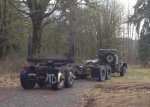PyroJoe
Member
- 86
- 13
- 8
- Location
- David City, NE
That contradicts every thread I've read (on this forum and others) about the NHC-250's in the past 24 hours. They all say do not exceed 200 psi. One went into detail about the size difference (2" vs 2.5") and how the smaller cam lobes tend to shear off. I'll stick with the majority on this one. This is, after all, about how to safely get more power out of a 250 - not how to live on the razor's edge.Anything under
You can run 215 to 220 injector pressure on a small cam
Found a really weird article about the NTC Formula series back when they were new in the 70's. They claimed you are better off driving the engines between 1000-1600 RPM rather than 1300-2000. They did a test and found the lower RPM yielded 7.3mpg while higher RPM gave 6.4mpg. Not sure if that only pertains to the NTC series, or the fact those motors have piston squirters, or maybe because they're turbo'd.
Cummins E290 | 3rd February 1978 | The Commercial Motor Archive
'Cummins E290' first printed in the 3rd February 1978 issue of Commercial Motor
archive.commercialmotor.com


